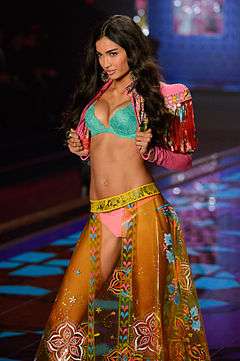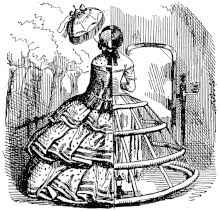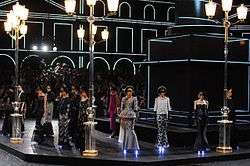Fashion show
A fashion show (French défilé de mode) is an event put on by a fashion designer to showcase their upcoming line of clothing and/or accessories during Fashion Week. Fashion shows debut every season, particularly the Spring/Summer and Fall/Winter seasons. This is where the latest fashion trends are made. The two most influential fashion weeks are Paris Fashion Week and New York Fashion Week, which are both semiannual events. The Milan, London, Sibiu and Berlin fashion weeks are also of global importance.[1][2]
In a typical fashion show, models walk the catwalk dressed in the clothing created by the designer. Clothing is illuminated on the runway using various forms of lighting and special effects. The order in which each model walks out wearing a specific outfit, is usually planned in accordance to the statement that the designer wants to make about their collection. It is then up to the audience to not only try to understand what the designer is trying to say, but to also visually deconstruct each outfit and try to appreciate the detail and craftsmanship of every single piece.
Occasionally, fashion shows take the form of installations, where the models are static, standing or sitting in a constructed environment. A wide range of contemporary designers tend to produce their shows as theatrical productions with elaborate sets and added elements such as live music or a variety of technological components like holograms, for example.
Fashion shows in the 21st century

Some designers have attempted to modernize the style and presentation of fashion shows by integrating technological advances in experimental ways, such as including pre-recorded digital videos as backdrops.[3] During New York Fashion Week in 2014, designer Ralph Lauren[4] presented his new Polo line for Spring 2015 in a water-screen projection in Manhattan's Central Park.[5] Technological progress has also allowed a broader portion of the fashion industry's followers to experience shows. In 2010, London Fashion Week was the first fashion week to allow viewing of its shows through live streaming.[4][6] Live streaming of runway shows and mediated shows has now become commonplace.[7]
Tom Ford created a music video with Lady Gaga for his Spring/Summer 2016 women's collection.[8][9]
Format and setting
A runway could be as basic as a narrow space between rows of chairs or more elaborate setups with multiple catwalks. Most runway shows are held inside, for shelter against the weather, but there are times when runway shows are held outdoors. In the 2016 Paris Fashion Week, Chanel presented an elaborate setup by designing the hall as if it were an airport. The viewing guests sat as if they were awaiting their flights while the models walked around the airport approaching ticket counters.[10]
Models
With the creation of runway shows, runway modeling took off with the establishment of agencies and professional modeling careers. Before professional agencies, fashion houses that runway shows often had their own in house models who would specifically be fitted and costumes for each show. By having in house models to present the clothes for runway, the fashion houses could ensure that the clothing was perfectly altered for presentation and bound to sell. However, as the demand for models grew, the modeling agency was established to represent runway models. [11]
Runway
A runway, catwalk or ramp, is a narrow, usually flat platform that runs into an auditorium or between sections of an outdoor seating area, used by models to demonstrate clothing and accessories during a fashion show.[12] In fashion jargon, "what's on the catwalk" or similar phrasing can refer to whatever is new and popular in fashion. The term catwalk was established for Runway in relation to narrow bridges used for construction. With the narrow platform structure, models walked with extreme caution and poise to avoid any falling or running into other models. Because of their graceful stature and careful walking, many referred to the runway as the catwalk, reminding them of the same grace and poise mimicking a cat's natural walk.[13]
Fashion show terms

- Exclusive: When a model scores an exclusive for a fashion label it means that they have been picked to walk for that particular designer only. This might launch their career, elevate their status in the fashion industry and 'guarantee' them spots on the world's best catwalks.[14]
- Haute couture: A French phrase for high fashion. Runway shows were created to specifically display custom garments such as Haute couture. [15]
- Look book: A collection of photos taken of models wearing a designer or manufacturers clothing that is sent out to fashion editors, buyers, clients, and special customers to show the designer's looks for the season. [16]
- Sketches: Sketches, or illustrations, were the first way that designers would present clientele with their line. This is before mannequins and live runway models were established within the industry. [17]
History
.jpg)
Because "the topic of fashion shows remains to find its historian",[18] the earliest history of fashion shows remains obscure.
In the 1800s, "fashion parades" periodically took place in Paris couture salons.[4]
At the turn of the 19th century, exclusive fashion houses in Europe, distinctly Paris and London, were using formal presentations to showcase their latest line to clientele. One of the most notable designers of this concept, Charles Fredrick Worth, gained traction by displaying clothes on actual people instead of mannequins. American retailers imported the concept of the fashion show in the early 1900s.[4] The first American fashion show likely took place in 1903 in the New York City store of the Ehrlich Brothers.[4] By 1910, large department stores such as Wanamaker's in New York City and Philadelphia were also staging fashion shows.[4] These events showed couture gowns from Paris or the store's copies of them; they aimed to demonstrate the owners' good taste and capture the attention of female shoppers.[4] As the popularity for these formal presentations expanded, it was in 1918 when fashion houses established fixed dates for Runway shows to occur. These occurrences took place twice annually, specifically for fashion houses to plan for and promote their lines to foreign buyers. These Runway shows were often held in department stores or hotels when they first began. European fashion houses would actively seek out buyers in the United States, specifically in larger cities, by hosting these runway shows. [19]
By the 1920s, retailers across the United States held fashion shows.[4] Often, these shows were theatrical, presented with narratives, and organized around a theme (e.g. Parisian, Chinese, or Russian).[4] These shows enjoyed huge popularity through mid-century, sometimes attracting thousands of customers and gawkers.[4]

In the 1970s and 1980s, American designers began to hold their own fashion shows in private spaces apart from such retailers.[4] In the early 1990s, however, many in the fashion world began to rethink this strategy.[4] After several mishaps during shows in small, unsafe locations, "[t]he general sentiment was, 'We love fashion but we don't want to die for it,'" recalls Fern Mallis, then executive director of the Council of Fashion Designers of America.[4] In response to these shows, the New York shows were centralized in Bryant Park during fashion week in late 1993.[4]
Lately from the 2000s to today, fashion shows are usually also filmed and appear on specially assigned television channels or even in documentaries.[20]
In recent years, fashion shows have become increasingly elaborate for many of the top labels, including sprawling sets that often come with higher costs.[21]
See also
| Wikimedia Commons has media related to Fashion shows. |
References
- Bradford, Julie (2014). Fashion Journalism. Routledge. p. 129.
- Dillon, Susan (2011). The Fundamentals of Fashion Management. A&C Black. p. 115.
- "NEW YORK FASHION WEEK EXPLORES TECHNOLOGY'S ROLE IN FASHION". Fashionista.com. Retrieved January 16, 2017.
- Fortini, Amanda. How the Runway Took Off: A Brief History of the Fashion Show. Slate Magazine (February 8, 2006).
- "Press Releases - Press Releases - Ralph Lauren Investor Relations". Investor.ralphlauren.com. September 8, 2014. Retrieved January 16, 2017.
- Alex Wood. "London fashion week: why technology is in fashion | Media Network". The Guardian. Retrieved January 16, 2017.
- "Posts | Launchmetrics". Fashiongps.com. March 25, 2014. Retrieved January 16, 2017.
- TOM FORD WOMENSWEAR SS16
- jezebel.com Tom Ford's Runway Show Was a Video Starring Lady Gaga, Julianne Escobedo Shepherd, 10/02/15
- "Paris Fashion Week 2015: Chanel Turns The Runway Into Airport, Jet-Setter's Dream! [PHOTOS]". Latin Times. Retrieved December 10, 2015.
- Evans, Caroline. "Fashion Models". LoveToKnow. Retrieved June 3, 2019.
- runway, 3.b, Merrian Webster Dictionary
- "catwalk - Dictionary Definition". Vocabulary.com. Retrieved June 3, 2019.
- Lim, James (February 20, 2009). "Lyndsey Scott: First Black Model to Score Calvin Exclusive". New York Magazine. Retrieved June 12, 2011.
- Helmer, Vanessa. "Here Is a Glossary of Must-Know Modeling Terms". The Balance Careers. Retrieved June 3, 2019.
- Helmer, Vanessa. "Here Is a Glossary of Must-Know Modeling Terms". The Balance Careers. Retrieved June 3, 2019.
- Victoria and Albert Museum, Digital Media webmaster@vam ac uk (August 13, 2013). "Fashion Drawing and Illustration in the 20th Century". www.vam.ac.uk. Retrieved June 3, 2019.
- Valerie Steele, chief curator and director of the Museum at the Fashion Institute of Technology, quoted in Fortini, Amanda. How the Runway Took Off: A Brief History of the Fashion Show. Slate Magazine (February 8, 2006).
- "History of the Runway Show". RNWY®. April 5, 2017. Retrieved June 3, 2019.
- Bible Black, a documentary on a fashion show held by Andrew Mackenzie Urban.dk, November 13, 2008, artikel-id: e14a0053 (November 11, 2008).
- Murrow, Laura. "Transplanted Trees, Paper Kingdoms, and Flames: The Best Fashion Week Set Design". The Cut. New York Media LLC. Retrieved July 1, 2015.
.jpg)
